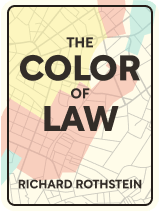

This article is an excerpt from the Shortform book guide to "The Color of Law" by Richard Rothstein. Shortform has the world's best summaries and analyses of books you should be reading.
Like this article? Sign up for a free trial here .
What was the role of residential segregation in enabling the racial wealth gap? Why does the racial wealth gap persist today?
Residential segregation contributed to the racial wealth gap because it prevented American Americans from building wealth through the ownership of property in high-value neighborhoods. The Black wealth gap has persisted because historical segregation has created a vicious cycle that ensures Blacks are less upwardly mobile than whites.
Read on to learn more about the role of segregation in creating the racial wealth gap.
The Vicious Cycle of Racial Residential Segregation
Epitomizing the cyclical nature of racial residential segregation, one of the reasons African Americans are less upwardly mobile than whites is their de facto confinement to poor neighborhoods. Poorer neighborhoods lack the services and opportunities—sufficiently staffed and equipped public schools, greengrocers, unpolluted air, safe streets—that put children on an upward trajectory.
For example, one 2013 study found that African Americans between the ages of 13 and 28 are now ten times more likely to live in poor neighborhoods than their white counterparts. The same study found that 67% of Black families who, a generation ago, lived in the poorest 25% of US neighborhoods continue to live in such neighborhoods. Whites who lived in such neighborhoods have fared much better: Only 40% of those families still live in the poorest neighborhoods.
Making matters worse, the value of homes in predominantly white neighborhoods has appreciated considerably in the last 50 or so years. This development has a dual effect: It makes homes in those neighborhoods even more unattainable for African Americans and it entrenches the intergenerational racial wealth gap between Blacks and whites (because white parents pass on their appreciated homes to their heirs).
Homes in and around the famous Levittown subdivision provide a stark example of this glaring racial wealth gap. In 1948, a one-bedroom in Levittown—which excluded African Americans—went for about $75,000 in today’s dollars. Today, that home—even without major remodels or updates—sells for about $350,000.
Compare this with nearby Lakeview, NY, a predominantly African American town. In 1948, a comparable one-bedroom house cost approximately $75,000 in today’s dollars, but today, that same one-bedroom house is only worth $90,000–$120,000. In short, Black families denied homes in Levittown missed out on 80% of the wealth generation enjoyed by Levittown’s white families.
Examples of Residential Segregation
Depressed incomes among African Americans led to racial residential segregation (because African Americans didn’t have the funds to relocate into white or integrated areas). But racial residential segregation also led to depressed incomes.
One way segregation exacerbated the Black wealth gap was through price gouging. Because African Americans were confined to particular neighborhoods, landlords in those neighborhoods were able to exploit their tenants. A common strategy was to subdivide single-family apartments into five or even six units, and then charge each tenant an excessively high rent. With nowhere else to go, tenants were forced to devote large proportions of their income to rent.
In Chicago, examples abound of exploitation by landlords. In 1946, a landlord divided a two-story building with a 540-square-foot footprint into six cubicles per floor. Each cubicle was rented to a single family at inflated prices, resulting in a total rent for the property that rivaled a luxury apartment on Chicago’s tony “Gold Coast.” At another property, after a fire killed ten Black tenants, an inquest revealed that a white tenant paying $15 a month had been evicted so that the landlord could charge a Black family $60 a month.
Another way segregation led to the racial wealth gap was through increased transportation costs. When a firm relocated from an integrated area to an area segregated for white residents only, Black workers were forced to commute, incurring fuel and/or public transportation costs and risking termination on account of absenteeism (due to transportation delays). For example, in 1955, Ford moved its Edgewater, NJ, plant to Mahwah, NJ. Mahwah zoning ordinances prevented African American workers from moving into the town, so they were forced to commute from places like Newark and New York City. By 1970, Black workers’ annual transportation costs ran between $1,000–$1,500—10% of their gross earnings.

———End of Preview———
Like what you just read? Read the rest of the world's best book summary and analysis of Richard Rothstein's "The Color of Law" at Shortform .
Here's what you'll find in our full The Color of Law summary :
- How racial residential segregation is the result of explicit government policy
- The three reasons why racial segregation is so difficult to reverse
- The steps that could lead to a more integrated and equitable society






